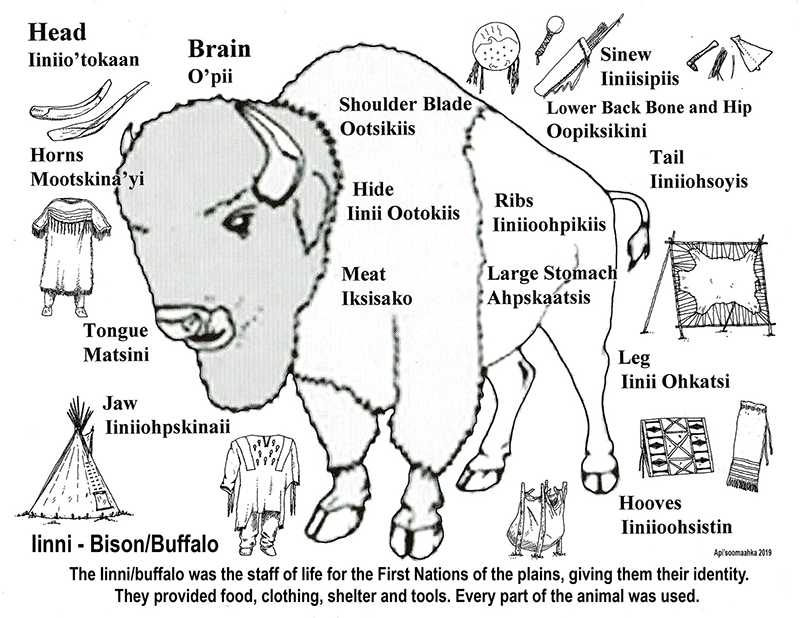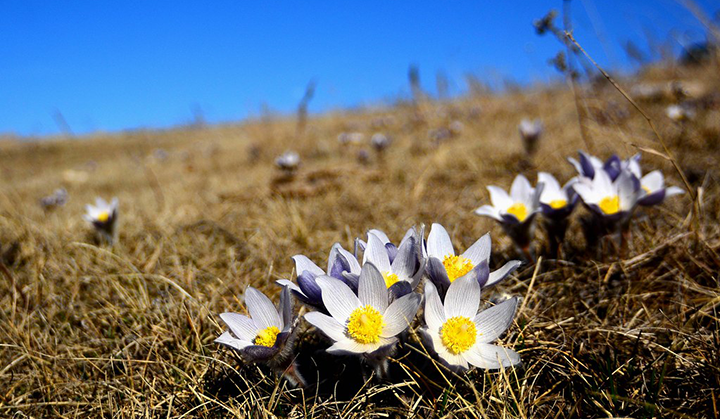Blackfoot language revitalization project shows how land, plants, animals and language are deeply interconnected
Increasingly, conservation is recognizing the importance of not only learning from Indigenous communities and knowledge-holders, but also trusting Indigenous leadership. A recent example where conservation is seen through a different lens is one of Y2Y’s 2020 partner grantees — the Blood Tribe Land Management’s Land Conservation Relationships project in Alberta’s Eastern Slopes.
The location of Kainai (Blood Tribe Reserve No. 148) First Nation is unique. It borders three headwaters in Canada (Belly River, St. Mary River, and Oldman River) in the South Saskatchewan River Basin; it also spans across foothills, important riparian areas and native prairies.
Guide brochure for conservation, culture and education
Through this project, the Naapi’s Garden guide brochure was created. The pamphlet shares information about Blackfoot Territory plants that are key to Blackfoot peoples’ food systems, and that have deep relationships with grizzly bears and bison.
The Buffalo Treaty of 2014 mentions conservation, culture, and education in its clauses. This pamphlet is created in fulfillment of those purposes of the Buffalo Treaty and to remind us of Naapi’s Garden, reads the brochure’s description.
The guide will also be part of Kainai Ecosystem Protection Association’s (KEPA) toolkit for the Indigenous Guardians program, and support Indigenous knowledge-based conservation with partners in this shared landscape.
According to KEPA, “The buffalo and grizzly bear were iconic beings for the Blackfoot. They were inextricably interrelated to the very being of Blackfoot people sustenance-wise, spiritually, culturally and linguistically. The disappearance of iconic symbols for a culture means the beginning of the disappearance of the culture and language that goes with it.”

How has Y2Y supported it?
The Yellowstone to Yukon mission progresses because of collaboration. That’s why we’re proud to continue with our partner grants program — one that has been running since 1998.
Through our 2020 partner grant program, Y2Y is proud to have supported the creation of the Blackfoot plants and animals relationships guide brochure for more than 50 plants deeply interconnected with Blackfoot peoples’ food systems, grizzly bears, bison and ecosystem health.
The buffalo and grizzly bear were iconic beings for the Blackfoot. They were inextricably interrelated to the very being of Blackfoot people sustenance-wise, spiritually, culturally and linguistically.
Kainai Ecosystem Protection Association
This photo and outreach project will be an important part of identifying plant species native to the Yellowstone to Yukon region that are also part of the “habitat mosaic” that buffalo and grizzly bear bring about. The guide also contributes to Indigenous language preservation and revitalization.
Y2Y’s partner grant program is one of the ways we support organizations and groups whose work underpins our mission — to connect and protect habitat from Yellowstone to Yukon so people and nature can thrive. These on-the-ground projects complement our efforts and mobilize work that we wouldn’t be able to do on our own.
In 2020, we funded 12 projects including this one, totaling $54,500. We are pleased to provide this financial support for the conservation community, because we know that it is only by working together that we will succeed.
Proud partners: Kainai Ecosystem Protection Association
The vision of Kainai Ecosystem Protection Association (KEPA) is for Kainai to value and live in a clean, healthy and protected environment that supports a sustainable society and balances economy and traditional connection to the air, water, land and animals. KEPA’s mission is to provide leadership through ecological consciousness and environmental stewardship by monitoring, resource management and conservation awareness, while promoting protection, sustainable development and partnerships.


